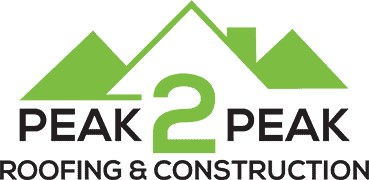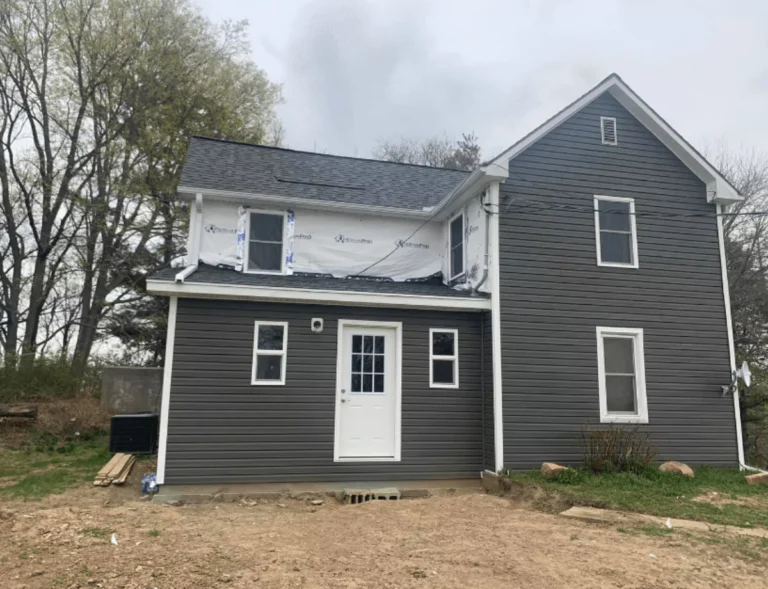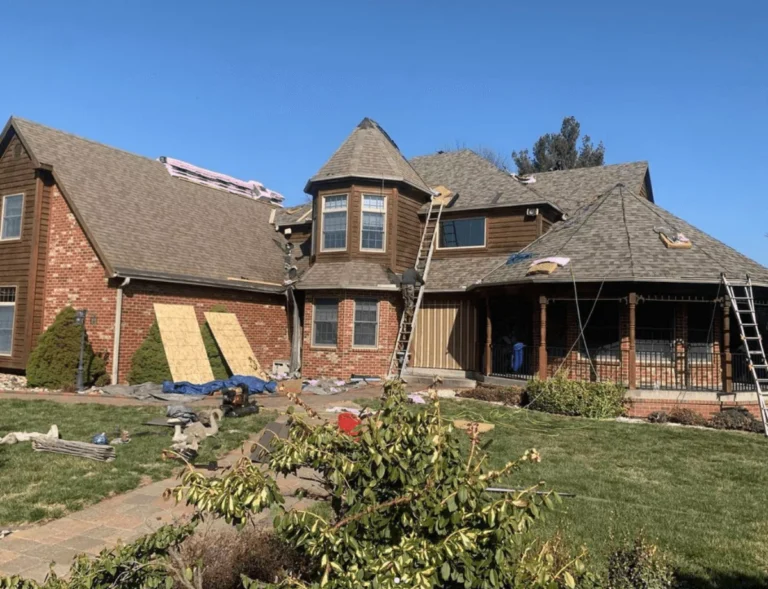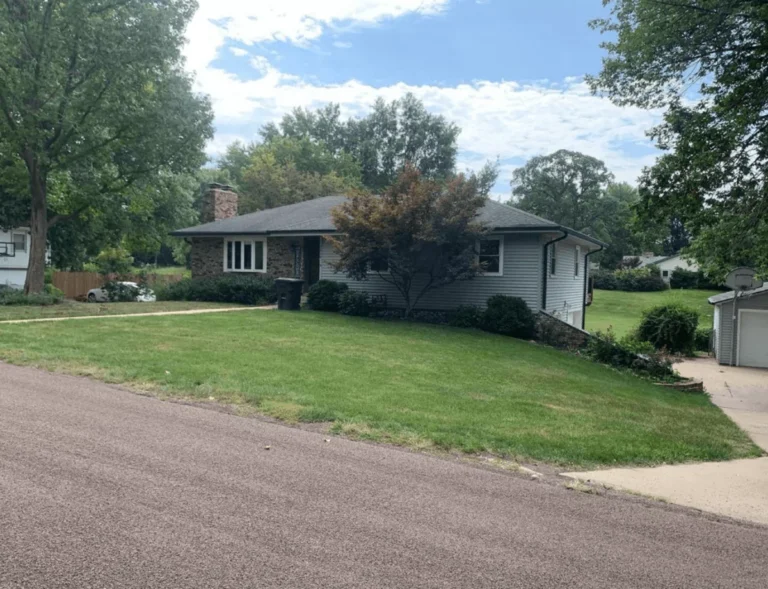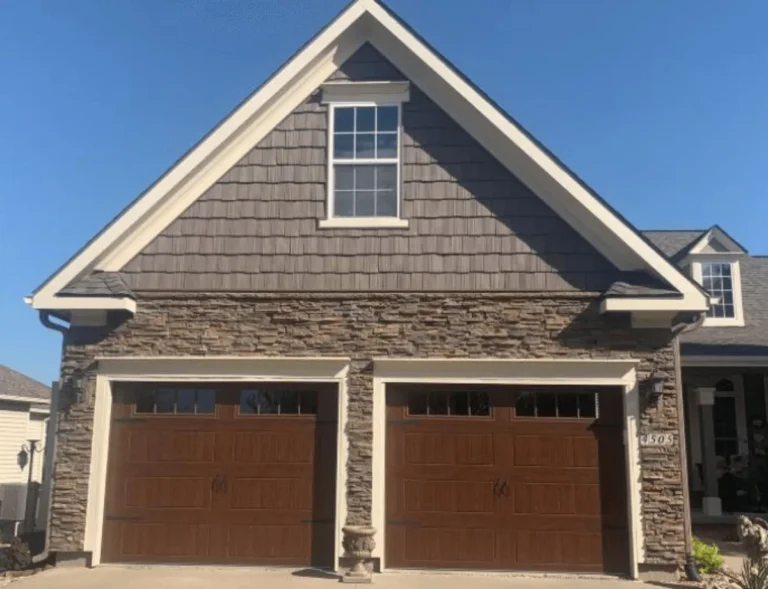Did you know that the average asphalt shingle roof lasts only about 20 years in the Midwest? For many homeowners, understanding whether insurance covers roof replacement can be confusing. At Peak 2 Peak Roofing Company, located at 7000 MO-371, St. Joseph, MO 64504, we often hear this question. Our goal is to provide clear answers and guide you through the process.
Homeowners insurance policies typically cover roof replacement when damage is caused by specific perils like storms, wind, or hail. However, policies vary, and understanding your coverage is crucial. In this article, we’ll explore what types of damage are covered, how policy details impact payouts, and why maintenance plays a significant role in claims. We’ll also discuss topics like ACV vs. RCV policies and deductible considerations.
As a trusted roofing company in St. Joseph, MO, we’re committed to transparency. We’ll use industry data, such as average roof lifespans and depreciation details, to back our recommendations. Whether you’re facing storm damage or planning for the future, we’re here to help. Contact us at 18162697874 or visit our website at https://www.peak2peakroofing.com/ for expert guidance.
A detailed wide-angle view of a residential roof replacement process unfolding on a sunny day. In the foreground, workers carefully remove old shingles, exposing the underlying structure. In the middle ground, a large crane lowers pallets of new roofing materials onto the site. Scaffolding surrounds the home, providing safe access for the skilled roofers. In the background, a clear blue sky with fluffy white clouds sets the tranquil mood. The scene conveys the technical expertise and care required for a successful roof replacement project.
Key Takeaways
- Home insurance often covers roof replacement for damages caused by storms, wind, or hail.
- Policy details like ACV vs. RCV significantly impact claim payouts.
- Regular roof maintenance is essential for valid insurance claims.
- Understanding your policy’s deductible and coverage limits is crucial.
- Consulting a local roofing expert can help navigate the insurance process.
Understanding Homeowners Insurance and Roof Replacement
Homeowners insurance typically covers roof replacement when damage results from specific perils like wind or hail. However, policies vary, and understanding your coverage is crucial. Most policies, like HO-3 and HO-5, cover a wide range of perils but exclude others like floods or wear and tear.
Coverage Under Dwelling Policies
Homeowners insurance usually covers roof damage under the dwelling coverage part of your policy. Policies like HO-3 and HO-5 cover most perils except those explicitly excluded. For example, damage from wind or hail is often covered, while wear and tear is not.
It’s important to note that older roofs may only be covered for their actual cash value, which factors in depreciation. In areas prone to severe weather, additional endorsements might be needed for wind or hail damage.
Excluded Perils and Conditions
Exclusions typically include flood damage, earthquakes, and normal wear and tear. Maintenance-related issues are usually not covered. Understanding these distinctions is key to knowing what your policy covers.
Reviewing your policy details with your insurance company is essential to ensure you’re adequately protected. At Peak 2 Peak Roofing, our local expertise and transparent approach can help you navigate these complexities and ensure your home is properly covered.
Will insurance cover roof replacement?
Homeowners often wonder if their insurance will help pay for a new roof. The answer depends on two main factors: the cause of the damage and the terms of your insurance policy.
Typically, homeowner insurance covers roof replacement if the damage is caused by a covered event, such as wind, hail, or fire. However, if the damage is due to wear and tear or lack of maintenance, it’s usually not covered.
Here’s what you need to know:
- Coverage depends on your roof’s age and the damage source
- Deductibles and policy type (ACV or RCV) affect payout amounts
- Documenting damage thoroughly is essential for a successful claim
Understanding your policy details is crucial. For example, older roofs might only be covered for their actual cash value, while newer roofs might qualify for replacement cost value. Always consult with your insurance company to clarify your coverage.
Factors Affecting Coverage for Roof Replacement
When it comes to roof replacement coverage, several factors come into play. Understanding these elements can help homeowners make informed decisions and avoid unexpected surprises.
Roof Age and Depreciation
One key factor is the age of your roof. Older roofs may only be covered for their actual cash value, which accounts for depreciation. For example, a 10-year-old roof might only receive $25,000 after depreciation and deductible, compared to a newer roof which might qualify for full replacement cost value, potentially $48,000 after deductible. This significant difference highlights the importance of considering roof age when evaluating insurance coverage.
Newer roofs, typically those under 10 years old, are more likely to be covered under replacement cost value (RCV), which means the insurance company will pay for a brand-new roof without deducting depreciation. This can be a significant advantage for homeowners with newer roofs.
Source of Damage and Policy Details
The cause of the damage is another critical factor. Damage caused by wind, hail, or fire is often covered, while issues due to wear and tear or lack of maintenance are typically excluded. For instance, if a storm causes significant hail damage, the insurance company is more likely to approve a full claim. However, if the damage is due to wear and tear or lack of maintenance, the claim may be denied or only partially covered.
It’s essential to review your policy details to understand what’s covered and what’s excluded. For example, some policies may require a separate deductible for wind or hail damage in certain areas. Understanding these nuances can help homeowners avoid unexpected out-of-pocket expenses.
Proper documentation and timely filing of claims are crucial for a smooth process. Additionally, regular maintenance can prevent minor issues from becoming major problems, which may not be covered by insurance.
ACV vs. RCV: Choosing the Best Option for Your Roof
When dealing with roof damage, understanding the difference between Actual Cash Value (ACV) and Replacement Cost Value (RCV) is crucial. These two approaches determine how your insurance company will reimburse you for repairs or a new roof.
Understanding Actual Cash Value
ACV considers the depreciated value of your roof. For example, if your 10-year-old roof is damaged, an ACV policy might pay $25,000 after depreciation and deductible. This option is often more affordable but offers less coverage for older roofs.
Benefits of Replacement Cost Value
RCV covers the full cost to replace your roof with a new one, without depreciation. For instance, a 5-year-old roof might receive $48,000 after deductible. This is ideal for newer roofs, providing better protection but at a higher premium.
Choosing the right option depends on your roof’s age and condition. If your roof is new, RCV offers more protection. For older roofs, ACV might be more cost-effective. Always discuss your options with your insurance provider to make an informed decision.
At Peak 2 Peak Roofing, we guide homeowners through these choices, ensuring your home is protected based on your specific needs.
Preventative Maintenance to Safeguard Your Roof
Regular maintenance is essential to protect your roof from damage and ensure your insurance claim is approved if needed. At Peak 2 Peak Roofing, we recommend a proactive approach to maintain your roof’s integrity and longevity.
Routine Inspections and Cleaning
Start with regular inspections. Check for damaged or missing shingles, curled edges, and signs of wear around vents and chimneys. Cleaning your roof and gutters regularly can prevent debris buildup, which can lead to water damage and ice dams in colder months.
- Clean gutters and downspouts to ensure proper water flow.
- Inspect shingles for cracks or missing granules.
- Trim tree branches near your roof to prevent damage from falling limbs.
By investing time in these simple steps, you can avoid costly repairs and ensure your insurance coverage remains valid. Remember, a well-maintained roof not only protects your home but also supports your insurance claim eligibility.
How to File a Roof Damage Claim Effectively
Filing a roof damage claim can be a complex process, but with the right approach, homeowners can ensure a smooth and successful experience. At Peak 2 Peak Roofing, we guide homeowners through each step, from documentation to follow-up, to maximize their claim’s success.
Documenting Damage Thoroughly
Immediate action is crucial after discovering roof damage. Take clear photos, videos, and written notes of all visible issues. This documentation serves as the foundation of your claim, helping your insurance company assess the extent of the damage accurately.
Communicating with Your Adjuster
Clear and prompt communication with your insurance adjuster is vital. Provide all documentation and maintain regular contact to avoid delays. A professional estimate from a licensed roofing contractor can also strengthen your case, ensuring all necessary repairs are accounted for.
Avoiding Common Filing Mistakes
Avoid common pitfalls like exaggerating damage or delaying your claim. Such mistakes can lead to claim denials or prolonged processing times. Understanding your policy’s deductibles and coverage limits is essential to set realistic expectations for your payout.
- Document damage immediately with photos, videos, and notes.
- Communicate promptly with your insurance company and adjuster.
- Avoid exaggerating damage or waiting too long to file.
- Secure a professional estimate from a licensed contractor.
- Understand your policy’s deductibles and coverage limits.
At Peak 2 Peak Roofing, we are committed to guiding homeowners through every step of the claim process, ensuring their homes are protected and their claims are successful.
Peak 2 Peak Roofing: Local Roofing Expertise in St. Joseph, MO
At Peak 2 Peak Roofing, we pride ourselves on being a trusted name in the St. Joseph, MO, community. Our commitment to quality and customer satisfaction has made us a go-to choice for homeowners seeking reliable roofing services.
Trusted Local Contractors and Contact Information
Located at 7000 MO-371, St. Joseph, MO 64504, our team is dedicated to providing exceptional service. You can reach us at 18162697874 or visit our website at https://www.peak2peakroofing.com/ for more information. For directions, please visit our Google Maps page.
Service Area and Commitment to Quality
We serve the entire St. Joseph area with a focus on delivering top-notch roofing solutions. Our expertise includes working closely with insurance companies to ensure smooth claim processing. We use high-quality materials and offer services ranging from preventative maintenance to emergency repairs.
Whether you need urgent repairs or routine maintenance, our team is ready to assist. Contact us today for a free estimate and let us help you protect your home with our professional roofing services.
Conclusion
Understanding whether your homeowner insurance policy covers roof replacement is crucial for protecting your home. Key factors include the cause of the damage, your policy details, and your roof’s condition. Regular maintenance and proper documentation are essential for valid claims.
Choosing between ACV and RCV policies depends on your roof’s age. ACV covers depreciated value, ideal for older roofs, while RCV offers full replacement cost, better for newer roofs. Timely filing and clear communication with your adjuster ensure a smooth process.
At Peak 2 Peak Roofing, we guide homeowners through these complexities. Our expertise in St. Joseph, MO, helps navigate insurance processes and ensures proper coverage. Contact us today at 18162697874 or visit our website for a free estimate and professional advice.
FAQ
What factors determine if my homeowner insurance will help pay for a new roof?
Your insurance policy typically covers roof damage caused by events like storms, hail, or falling trees. However, the age and condition of your roof, as well as the type of damage, will influence coverage. Review your policy to understand what’s included and any exclusions.
How does the type of roofing material affect my insurance claim?
Different materials have varying costs and durability. For instance, hail can severely damage shingles, while metal roofs may withstand such events better. Your insurance adjuster will assess the material and damage to determine if repair or replacement is needed.
What is the difference between Actual Cash Value (ACV) and Replacement Cost Value (RCV) in my policy?
ACV accounts for depreciation and pays the current value of your roof. RCV covers the full cost to replace your roof with new materials, without considering depreciation. Check your policy to see which applies to your claim.
How do I file a claim for roof damage effectively?
Start by documenting all damage with photos and notes. Contact your insurance company promptly to report the claim. Be prepared to discuss details with your adjuster and ask questions to understand the process and timeline.
Can I choose which roofing company to repair or replace my roof?
Yes, you can select a trusted local roofing company. Ensure they are licensed and insured. Discuss your options with your insurance adjuster to confirm coverage and get approval before starting work.
What steps can I take to prevent future roof damage?
Regular inspections, trimming nearby trees, and cleaning debris can help prevent damage. Ensure your roof is well-maintained to avoid issues caused by wear and tear.
How long does a typical roof insurance claim take to process?
Claims can take anywhere from a few days to several weeks, depending on the extent of damage and complexity of the claim. Keep communication open with your adjuster to stay updated on progress.
What if my insurance company denies my roof damage claim?
If your claim is denied, review the reasons and appeal if necessary. Provide additional documentation or seek a second inspection if needed. Understanding your policy terms can help in resolving disputes.
How does the age of my roof affect the insurance claim process?
Older roofs may have depreciation factored into the claim. If your roof is near or past its expected lifespan, coverage might be limited. Check your policy for specific terms regarding roof age and wear.
